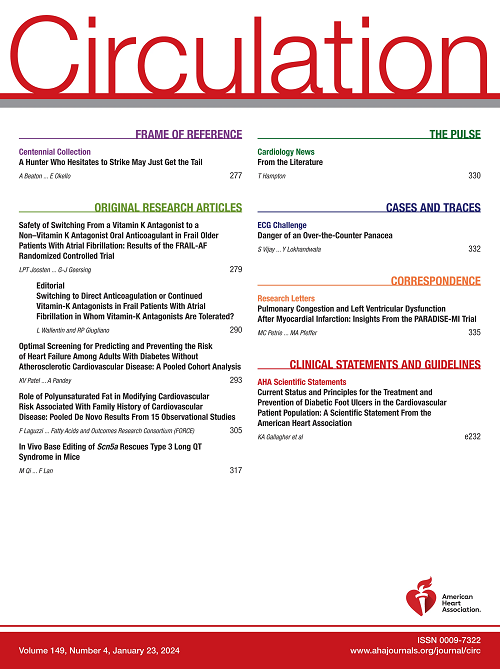移植动脉硬化中线粒体1-碳代谢驱动cd34谱系细胞分化为T滤泡辅助细胞形成三级淋巴器官
IF 35.5
1区 医学
Q1 CARDIAC & CARDIOVASCULAR SYSTEMS
引用次数: 0
摘要
背景:同种异体移植动脉硬化是移植失败的一个重要原因,它与三级淋巴器官的形成有关。T滤泡辅助细胞(Tfh)是辅助T细胞的一个重要亚群,控制着三级淋巴器官生发中心的形成。因此,了解Tfh细胞在同种异体移植动脉硬化中的起源和调控机制对于开发靶向治疗至关重要。方法采用谱系追踪策略追踪小鼠模型中Tfh细胞的命运。采用单细胞RNA测序、流式细胞术和免疫荧光染色分析移植后2周和4周重构动脉的细胞群。此外,我们使用VEGFR-3抑制剂和淋巴结清扫来抑制淋巴管的形成。利用基于高效液相色谱和高分辨率质谱的代谢组学研究了不同细胞类型的代谢特征和通量。我们使用CD4+ T细胞特异性MTHFD2敲除小鼠来证实我们关于线粒体1-碳代谢在Tfh细胞分化中的作用的假设。在体内发现的机制也在体外进行了测试。结果发现scd34谱系细胞是同种异体移植动脉中分化为T细胞群的主要细胞来源。cd34谱系细胞主要来源于胸腺,经淋巴管引流,在移植动脉周围分化为有效的T细胞。使用CD34谱系追踪小鼠和单细胞RNA测序,我们鉴定了来自CD34谱系CD4+ T细胞的Tfh细胞群。非靶向和靶向代谢组学显示,在CD4+ t向tfh细胞分化过程中,1-碳代谢明显上调。补充1-碳代谢必需的氨基酸,如丝氨酸、蛋氨酸或甘氨酸,促进CD4+ T细胞向Tfh细胞的分化。使用氘标记的丝氨酸,我们发现线粒体1-碳途径占主导地位。通过给药DS18561882或产生CD4+ T细胞特异性MTHFD2敲除小鼠抑制线粒体1-碳代谢酶MTHFD2,可显著抑制Tfh细胞的数量和第三淋巴器官的形成以及血管重构。结论本研究揭示了线粒体1-碳代谢和MTHFD2在cd34谱系细胞向Tfh细胞分化过程中的关键作用,这有助于移植血管病变中三级淋巴器官的形成,为提高移植效果提供了潜在的治疗靶点。本文章由计算机程序翻译,如有差异,请以英文原文为准。
Mitochondrial 1-Carbon Metabolism Drives CD34-Lineage Cells to Differentiate Into T Follicular Helper Cells to Form Tertiary Lymphoid Organs in Transplant Arteriosclerosis.
BACKGROUND
Allograft arteriosclerosis, a significant cause of graft failure, is linked to the formation of tertiary lymphoid organs. T follicular helper (Tfh) cells are a vital subset of helper T cells that control the formation of the germinal center in tertiary lymphoid organs. Thus, understanding the origins and regulatory mechanisms of Tfh cells in allograft arteriosclerosis is essential for developing targeted therapies.
METHODS
We used a lineage-tracing strategy to track Tfh cell fate in mouse models. Single-cell RNA sequencing, flow cytometry, and immunofluorescence staining were employed to analyze cell populations in remodeled arteries 2 and 4 weeks after transplantation. Additionally, we used VEGFR-3 inhibitors and lymph node dissection to suppress lymphatic vessel formation. Metabolic signatures and flux in different cell types were investigated using ultrahigh-performance liquid chromatography and high-resolution mass spectrometry-based metabolomics. CD4+ T cell-specific MTHFD2 knockout mice were used to corroborate our hypothesis about the role of mitochondrial 1-carbon metabolism in Tfh cell differentiation. Mechanisms discovered in vivo were also tested ex vivo.
RESULTS
CD34-lineage cells were found to be the major source of cells differentiating into T cell populations in allograft arteries. CD34-lineage cells mainly originated from the thymus, with drainage through lymphatic vessels, and differentiated into effective T cells around grafting arteries. Using CD34 lineage-tracing mice and single-cell RNA sequencing, we identified a Tfh cell population derived from CD34-lineage CD4+ T cells. Untargeted and targeted metabolomics revealed distinct upregulation of 1-carbon metabolism during CD4+ T-to-Tfh cell differentiation. Supplementation of amino acids essential for 1-carbon metabolism, such as serine, methionine or glycine, facilitated differentiation from CD4+ T to Tfh cells. Using deuterium-labeled serine, we found that the mitochondrial 1-carbon pathway is predominant. Inhibition of the mitochondrial 1-carbon metabolic enzyme MTHFD2 by administration of DS18561882 or generating CD4+ T cell-specific MTHFD2 knockout mice, significantly inhibited the numbers of Tfh cells and tertiary lymphoid organ formation as well as vascular remodeling.
CONCLUSIONS
This study provides insights into the critical role of mitochondrial 1-carbon metabolism and MTHFD2 in governing the differentiation of CD34-lineage cells into Tfh cells, which contributes to tertiary lymphoid organ formation in transplant vasculopathy, offering potential therapeutic targets to enhance transplant outcomes.
求助全文
通过发布文献求助,成功后即可免费获取论文全文。
去求助
来源期刊

Circulation
医学-外周血管病
CiteScore
45.70
自引率
2.10%
发文量
1473
审稿时长
2 months
期刊介绍:
Circulation is a platform that publishes a diverse range of content related to cardiovascular health and disease. This includes original research manuscripts, review articles, and other contributions spanning observational studies, clinical trials, epidemiology, health services, outcomes studies, and advancements in basic and translational research. The journal serves as a vital resource for professionals and researchers in the field of cardiovascular health, providing a comprehensive platform for disseminating knowledge and fostering advancements in the understanding and management of cardiovascular issues.
 求助内容:
求助内容: 应助结果提醒方式:
应助结果提醒方式:


